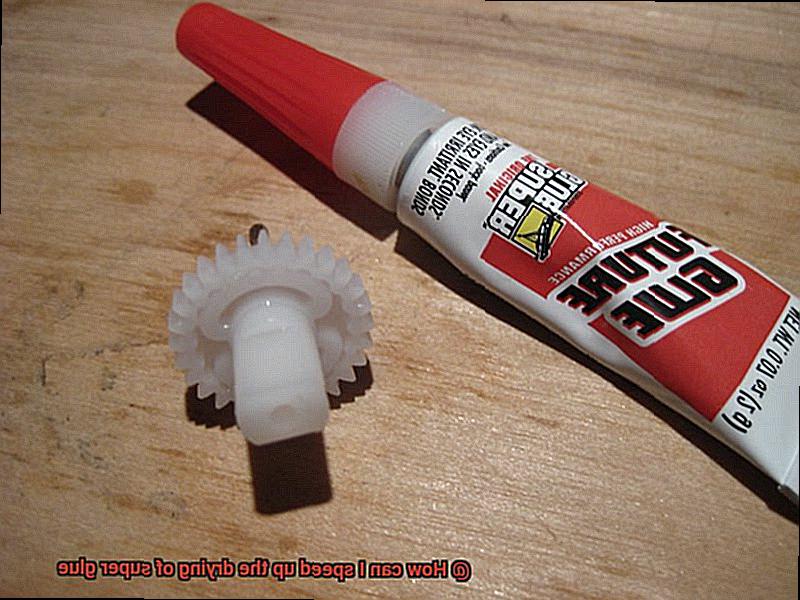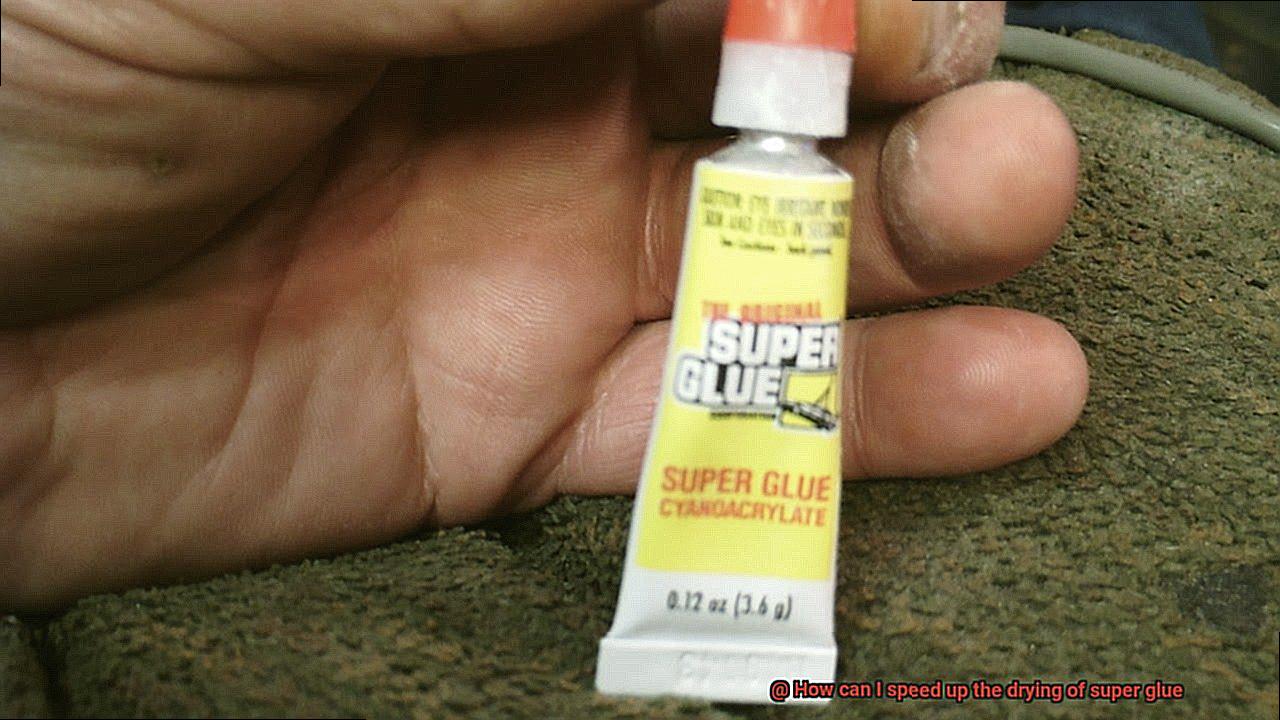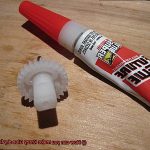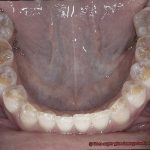Are you tired of waiting around for your super glue to dry?
We’ve all been there – stuck in the middle of a project, itching to move forward, but the darn glue just won’t set. Well, worry no more.
In this blog post, we’re going to spill the beans on some tried-and-true methods for speeding up the drying process of super glue. Whether you’re knee-deep in a DIY project, desperately trying to fix something that broke at the worst possible moment, or simply running out of time, these tips will have your back.
So, buckle up and get ready to discover how to make your super glue dry faster than lightning.
What is Super Glue?
Contents
- 1 What is Super Glue?
- 2 Why Speed Up the Drying of Super Glue?
- 3 Using Accelerators to Speed Up the Drying of Super Glue
- 4 Applying Heat to Speed Up the Drying of Super Glue
- 5 Adding Moisture to Speed Up the Drying of Super Glue
- 6 Ensuring Proper Ventilation to Speed Up the Drying of Super Glue
- 7 Using Thinner Layers to Speed Up the Drying of Super Glue
- 8 Safety Guidelines for Speeding up the Drying of Super Glue
- 9 Conclusion
In a world where broken items and creative visions abound, there exists a hero that can save the day in an instant. Its name? Super glue, the adhesive superhero. Prepare to be captivated as we dive into the captivating world of super glue—its features, advantages, applications, and even some tips to speed up the drying process. Get ready to witness the power of this versatile adhesive.
Super Glue: A Bonding Marvel:
Imagine a substance that can create an unbreakable bond between different materials in the blink of an eye. This is the magic of super glue, also known as cyanoacrylate adhesive. Developed by the brilliant Dr. Harry Coover in the 1940s, this compound was initially designed as a protective coating for optical instruments during World War II. Little did Dr. Coover know, his creation would soon become renowned for its exceptional adhesive properties.
Features and Advantages:
- Strong Bonds: Super glue possesses unparalleled bonding strength, making it the ideal adhesive for various materials like metal, plastic, rubber, wood, and ceramics. From fixing broken household items to crafting intricate projects, super glue ensures durable bonds that stand the test of time.
- Lightning-Fast Setting Time: One of super glue’s defining features is its rapid setting time. Within seconds or minutes after application, this adhesive solidifies and creates an unyielding bond. This characteristic allows for efficient repairs and projects, saving you precious time.
- Versatility at Its Finest: Super glue is a jack-of-all-trades when it comes to bonding applications. Whether you’re repairing jewelry, assembling models, or engaging in DIY projects, this adhesive is your go-to solution.

Applications:
- Household Repairs: Say goodbye to shattered dishes and loose tool handles. Super glue can fix broken ceramic dishes, repair torn leather goods, mend loose screws, and reattach small parts like knobs or buttons.
- Crafts and Hobbies: For craft enthusiasts, super glue is the ultimate companion. From jewelry making to model building, its precise application and robust bond guarantee flawless results.
- Automotive and DIY Projects: Loose trim? Small part in your car needs securing? Super glue comes to the rescue, providing a reliable and long-lasting solution for automotive repairs and DIY projects.
Tips to Speed Up Drying Time:
- Accelerators: Unlock the secret of faster drying by utilizing accelerators specifically designed for cyanoacrylate adhesives. These products, available in spray or gel form, significantly reduce setting time.
- Apply Heat: Harness the power of heat to expedite the drying process. Gently blow hot air onto the glued area using a low or medium heat setting on a hairdryer. Witness the magic as heat accelerates chemical reactions, leading to faster drying.
- Add Moisture: Embrace the art of moisture to promote faster bonding. Lightly dampen one of the surfaces before applying super glue. This technique works wonders, especially for porous materials like wood or fabric.
- Ensure Proper Ventilation: Good airflow aids in moisture evaporation, facilitating faster drying. Open windows or use fans to create a well-ventilated environment without directly blowing onto the glued area.
- Thin Layers: Optimize drying time by applying thin, even coats of super glue. Tight fitting of surfaces being bonded also speeds up the drying process.
Why Speed Up the Drying of Super Glue?
Super glue, also known as cyanoacrylate adhesive, is a remarkable adhesive that can create strong and durable bonds in a matter of seconds. But waiting for it to dry naturally can be a real drag, especially when you’re working on time-sensitive projects or repairs. That’s why speeding up the drying process is a game-changer.
Here are three compelling reasons why it’s beneficial to speed up the drying of super glue:
- Quick and Efficient Bonding: By accelerating the drying process, you ensure that the materials you’re bonding together adhere quickly and effectively. No more waiting around for hours on end – with super glue that dries in a flash, you can complete your project in a fraction of the time. It’s like having a magical adhesive that works at the speed of light.
- Minimize Displacement Risks: Have you ever experienced the frustration of a glued object shifting or falling apart because you couldn’t wait for the glue to dry naturally? It’s infuriating. But by speeding up the drying process, you significantly reduce the risk of accidental disruption. No more worrying about delicate bonds breaking before they’re fully set. With super glue that dries in an instant, your creations will stay put and withstand whatever life throws at them.
- Increased Productivity: If you’re someone who frequently uses super glue for various tasks, reducing the drying time can be a game-changer for your productivity. Whether you’re a crafting enthusiast, a repair professional, or just someone who loves getting things done efficiently, being able to complete your projects more quickly is a real game-changer. With super glue that dries in record time, you’ll save valuable hours and energy – a win-win situation.
It’s important to note that while speeding up the drying process can have numerous advantages, it’s crucial to follow proper safety precautions. Don’t rush the drying excessively or resort to inappropriate methods. Remember, your safety and the quality of the bond are paramount.
Using Accelerators to Speed Up the Drying of Super Glue
Enter accelerators, the secret ingredient that can turbo-charge the drying process of super glue.
Accelerators: The Need for Speed:
Accelerators, also known as activators or primers, are like the race cars of the glue world. They rev up the drying process by initiating a chemical reaction that causes the glue to cure faster. Here’s how they work:
Spray or Liquid Accelerators:
Imagine a spray or liquid that can transform super glue into a drying superhero. These accelerators are applied directly onto the glued surface, triggering an instant reaction with the glue. Perfect for those larger projects or when time is of the essence.
Powder Accelerators:
Powder accelerators are like microscopic moisture-absorbing superheroes. Sprinkle them onto the glued area, and witness their magic as they absorb moisture from the glue, accelerating the drying process. This method is particularly handy when working with porous materials that naturally take longer to dry.
Compatibility and Safety First:
Before you hit the accelerator pedal, it’s crucial to check if your super glue brand is compatible with accelerators. Different formulations may react differently, so always refer to the manufacturer’s instructions or product specifications.
Remember, safety first. Some accelerators contain volatile chemicals that can be harmful if mishandled. Protect yourself by wearing gloves and goggles, and always work in a well-ventilated area.
The Need for Balance:
Like all good things in life, balance is key when using accelerators. While they can speed up drying time and improve bond strength, excessive use may have adverse effects. Too much accelerator can weaken the bond or result in incomplete curing. So, apply accelerators sparingly and keep a watchful eye on the drying process.
Conclusion:
Accelerators are the secret sauce to super glue’s need for speed. By initiating a chemical reaction, they turbo-charge the drying process, resulting in quicker and stronger bonds. Just remember to choose the right type of accelerator, follow safety precautions, and use them in moderation.
Applying Heat to Speed Up the Drying of Super Glue
The application of heat can work wonders when it comes to speeding up the drying process of super glue. Understanding how heat interacts with the glue can help us grasp why this technique is so effective.
When heat is applied to super glue, it sets off a chemical reaction that accelerates the hardening process. Essentially, the heat breaks down the molecules in the glue, allowing them to bond more quickly and solidify. This phenomenon is nothing short of fascinating.
Now, let’s delve into the best methods for applying heat. One popular option is to use a hairdryer. By setting the hairdryer to a low or medium heat setting and holding it a few inches away from the glued area, you can evenly distribute the heat necessary to expedite the drying process.
Gently moving the hairdryer back and forth over the glue will further enhance its effectiveness. With this technique, you’ll be amazed at how quickly your super glue dries.
If you’re seeking an even swifter drying process, a heat gun is your go-to tool. The intense heat generated by a heat gun can dry the glue at an accelerated pace.
However, caution must be exercised when using a heat gun, as it can generate high temperatures that may damage certain materials or cause burns if not used properly.
While applying heat can indeed speed up the drying process, there are safety precautions to keep in mind. Avoid holding the hairdryer too close or using high heat, as this can cause the glue to bubble or burn. Remember, safety first.
Additionally, excessive heat can make the glue more brittle, potentially weakening its bond. Therefore, it is advisable to use heat sparingly and only when a quick bond is necessary.
Lastly, it’s crucial to note that applying heat should not be seen as a substitute for allowing sufficient curing time for maximum strength. Even with accelerated drying, it remains essential to let the glue fully cure to ensure optimal performance.
Adding Moisture to Speed Up the Drying of Super Glue
We’ve all experienced the frustration of waiting for super glue to dry. But fear not. In this article, we’ll delve into the exciting world of accelerating super glue drying by adding moisture. So grab your water mister, and let’s dive in.
The Science Behind It:
Super glue, also known as cyanoacrylate adhesive, cures through a reaction with moisture in the air. By introducing additional moisture, you’re essentially providing more “fuel” for the glue to react with, resulting in faster curing. It’s like giving your glue a turbo boost.
How to Add Moisture:
There are various ways to introduce moisture and speed up the drying process. Try these methods:
- Water Mister or Spray Bottle: Lightly mist the glued area with water using a mister or spray bottle. This provides a fine layer of moisture without oversaturating the surface, preventing any potential weakening of the bond.
- Breath Method: Blow on the glued area, allowing the moisture in your breath to interact with the super glue and expedite drying. While not as effective as a mister or spray bottle, this method can still provide some acceleration.
Timing Is Key:
For optimal results, add moisture immediately after applying the super glue. Once the glue starts to dry and form a bond, additional moisture may have little impact on curing time.
Consider Other Factors:
While moisture is crucial for quick drying, other factors also come into play:
- Temperature: Higher temperatures generally result in faster curing, while colder temperatures slow it down. Keep this in mind when working in different environments.
- Humidity: Higher humidity levels can expedite drying, while lower humidity levels may prolong curing time. Adjusting humidity levels or working in a naturally humid environment can aid in accelerating drying.
Take Safety Precautions:
When handling super glue and adding moisture, exercise caution:
- Read the Manufacturer’s Instructions: Follow safety guidelines provided by the manufacturer to ensure safe handling and application.
- Protect Yourself and Surfaces: Super glue bonds quickly and can adhere to unintended surfaces, including skin. Wear gloves and use protective barriers when necessary.
Ensuring Proper Ventilation to Speed Up the Drying of Super Glue
Super glue is a powerful adhesive that can bond surfaces together quickly and securely. However, waiting for it to dry can be a test of patience. Luckily, there are ways to speed up the drying process by ensuring proper ventilation. In this article, we will explore the importance of ventilation and provide tips to help you turbo-charge the drying time of super glue.
Embrace Fresh Air:
Proper ventilation is vital for super glue to dry quickly and effectively. When exposed to fresh air, a chemical reaction called polymerization occurs, causing the glue to harden and form a strong bond. To maximize ventilation, choose a well-ventilated area with natural airflow or utilize fans or air conditioning systems.
Eliminate Moisture:
Moisture is the nemesis of super glue drying time. It slows down the bonding process and can lead to frustration. Proper ventilation plays a crucial role in reducing moisture by decreasing humidity levels and promoting air circulation. Remember, less moisture means faster drying.
Fan It Out:
If you’re in a hurry to see results, grab a portable fan or blow dryer set on a cool setting. Directing airflow towards the glued surface helps evaporate lingering moisture and accelerates the drying process. Maintain a safe distance from the glue to avoid potential heat damage.
Embrace Warmth (with Caution):
Heat can be an ally in speeding up super glue drying time, but it must be used carefully. Excessive heat can make the glue brittle or weaken its bond strength. Opt for low heat sources such as warm water or a hairdryer on a low setting. Always maintain a safe distance to prevent mishaps.
Cover All Bases:
When working with larger surfaces or multiple glued parts, proper ventilation becomes even more crucial. Ensuring that fresh air reaches all areas of the glued surface helps distribute heat and moisture evenly, resulting in faster and more effective drying.
Using Thinner Layers to Speed Up the Drying of Super Glue
We have a solution that will have you zipping through your projects in no time. By using thinner layers of super glue, you can speed up the drying process and get back to creating.
In this blog post, we will explore the science behind why thinner layers dry faster and provide you with practical tips for achieving speedy results.
The Science behind Thinner Layers:
How to Apply Thinner Layers:
- Minimal application: Begin by applying a small amount of super glue to your desired surface.
- Even distribution: Spread the glue evenly using a toothpick, brush, or even the nozzle of the super glue bottle itself. This guarantees uniform coverage and prevents the formation of thick layers.
Benefits of Thinner Layers:
- Rapid drying time: As mentioned earlier, thinner layers dry faster thanks to increased air exposure.
- Diminished heat buildup: Thicker layers generate excessive heat during curing, which can damage or warp heat-sensitive materials. Thinner layers mitigate this issue.
Considerations when using Thinner Layers:
- Bond strength versus drying time: Thinner layers may not offer the same bond strength as thicker ones. Evaluate your project’s requirements and decide if sacrificing some strength for quicker drying is acceptable.
- Alignment and positioning: Thinner layers set faster, allowing less time for adjustments before the bond becomes permanent. Ensure proper alignment and positioning before applying the glue.
Safety Guidelines for Speeding up the Drying of Super Glue
We all know that waiting for glue to dry can be tedious, especially when you’re excited to see the final result of your project. But before we dive into the exciting tips and tricks, let’s talk about safety.
It’s essential to prioritize safety measures when working with super glue to avoid accidents or injuries. So, buckle up and let’s explore the safety guidelines for speeding up the drying process of super glue.
Use Protective Gear:
Put safety first. Super glue can be hazardous if it comes into contact with your skin or eyes. Ensure you’re wearing protective gloves and eyewear when handling the glue. Safety goggles will shield your eyes from potential irritation caused by fumes or accidental splashes.
Follow Manufacturer’s Instructions:
While we’re all eager to quicken the drying process, it’s important to stick to the manufacturer’s instructions. Deviating from their recommended usage guidelines may compromise the adhesive bond or pose additional risks. So, read those instructions carefully.
Ventilation is Key:
Working in a well-ventilated area is crucial to prevent inhaling any fumes from the super glue. Open windows and doors, or use fans to improve air circulation during application and drying. Fresh air will keep you feeling invigorated and safe.
Apply Thin Layers:
Using excessive amounts of super glue can lead to longer drying times and potential messiness. Apply thin and even layers for faster and more efficient drying. Remember, less is more.
Delicate Surfaces Beware:
Be cautious when applying super glue on sensitive or delicate surfaces such as skin, fabrics, or certain plastics, as it may cause damage. Opt for specialized glues specifically designed for these materials or consider alternative adhesive options.
Clean and Dry Surfaces:
Preparation is key. Before applying super glue, ensure that the surfaces are clean and dry. Any moisture or contaminants on the surface can interfere with the adhesive’s effectiveness and prolong drying time. A clean canvas guarantees a speedy bond.
Patience is a Virtue:
As tempting as it may be to rush the drying process, it’s essential to exercise patience. Allowing adequate time for the glue to dry naturally ensures the strongest bond. Great things come to those who wait.
Read and Follow Instructions:
Last but not least, always read and follow all safety warnings and guidelines provided by the manufacturer of your specific brand of super glue. Each product may have unique instructions or precautions for optimal results and safety. Be in the know.
3oQMFWFbOw8″ >
Also Read: How To Make Super Glue Dry Faster
Conclusion
Speeding up the drying of super glue can be a game-changer when you’re in a hurry to complete a project. Luckily, there are a few tricks you can try to make the process faster and more efficient.
One method is to use an accelerator or activator specifically designed for super glue. These products contain chemicals that help to speed up the curing process, allowing the glue to dry in seconds rather than minutes. Simply apply a small amount of the accelerator onto the glued area, and watch as it magically sets in no time.
Another technique is to use heat to accelerate the drying process. You can do this by using a hairdryer on its lowest heat setting and directing it towards the glued area. The warm air helps to evaporate any moisture present in the glue, causing it to dry faster. Just be careful not to hold the hairdryer too close or use excessive heat, as this could potentially damage delicate materials.
If you’re working with larger surface areas or need an even quicker fix, consider using a cyanoacrylate adhesive instead of regular super glue. Cyanoacrylates are similar to super glue but have a faster curing time, allowing them to dry almost instantly upon application.
In addition to these methods, ensuring that you’re using the right amount of glue is crucial for speedy drying. Applying too much glue can prolong drying time as excess moisture takes longer to evaporate. By using just enough adhesive for your project, you can expedite the drying process significantly.
Remember, though, that while these techniques may speed up the drying time of super glue, it’s essential to follow safety precautions and work in a well-ventilated area. Additionally, always read and follow the instructions provided by the manufacturer for optimal results.






